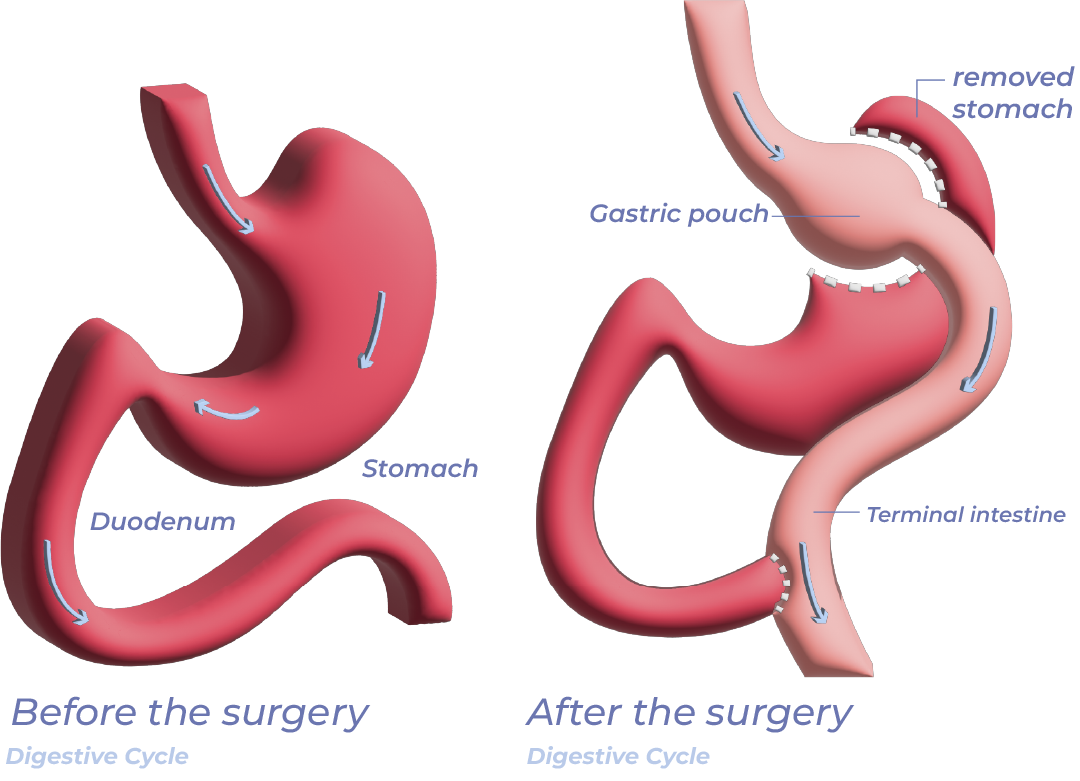Gastric bypass
procedures bariatric
Bariatric procedures are metabolic-focused procedures that seek to combat directly Several of the causes (and not only the symptoms of obesity) and their associated diseases and limitations, facilitate the patient a change of nutritional habits and the proper activation of metabolic processes from the nutritional front, thus giving them a real possibility of successfully, quickly and significantly reducing their overweight.
The different bariatric surgeries change from each other according to the techniques and procedures developed by medicine, some being better indicated than others according to several factors that are part of each patient’s situation.
Gastric bypass
Through this procedure I get a new way of transit for the
food that the patient ingests, avoiding its passage through
the stomach (Food they pass for a new and small reservoir
created to act as a stomach) and other areas such as
the pancreas and the duodenum
How do I achieve it?
Directly connecting the anterior and posterior
intestines to the aforementioned areas. This is how I
get 3 results that offer benefits to the patient:
- 1. Prolong the feeling of satiety and achieve it with the intake of less food thanks to the smaller size of the new "stomach".
- 2. We avoid the passage of food through the area of the duodenum and pancreas, which are organs that assimilate fats and sugars, and where the origin of diabetes is. That's why it's called Bypass.
- 3. Avoid the food assimilation rate by avoiding areas of the stomach and digestive tract, so the patient manages to lose weight and reap metabolic benefits that will help him even heal diseases associated with obesity. This also applies to nutrients and vitamins, so the patient must follow a special nutrition diet that compensates for the reduction in the assimilation of these.

There are different techniques to perform this bypass in the digestive
system, in my case the location of the connection points of this new
intestinal transit route will depend on the patient’s diagnosis and the
benefits we seek or damages we want to vitamin, therefore the Bypass
is treated as a tailor-made procedure.
Benefits
- Is a surgery that loses weight very quickly, up to 70% to 90% of the patient's excess weight
- Gastroesophageal reflux Immediately after the surgery since it's an anti-reflow surgery as well
- Diseases Related to obesity, such as type 2 diabetes, hypertension, gastroesophageal reflux, or sleep apnea, can begin to improve even before losing weight.
- Being considered a metabolic surgery with the correct diagnosis of type 2 diabetes, a shorter bypass can be performed in patients with BMI greater than 25 with adequate nutritional control
Ideal for
For patients between 18 and 65 years of age, however, age is not a limiting factor, you must make the consultation and according to your case we suggest your best intervention
Patients with a BMI greater than 35 or if it is a BMI between 30 and 35 with obesity-related diseases such as diabetes, hypertension, and sleep apnea.
However, gastric bypass is a technique especially indicated for
patients with a tendency to eat or peck between hours and that
they have a compulsive relationship with food.
The patient may follow a plan of change of habits before surgery
through multidisciplinary accompaniment so that they can able
to receive it and to have a better relationship and assimilation of
their new and better eating habits after this.
Advantages
- It is a minimally invasive technique, almost painless and the patient's recovery is very fast.
Ventajas
- Contrary to what happens with the gastric sleeve, the bypass is a reversible procedure. That is, it can be recovered to return to the initial state.
Procedure
The surgeon performs small incisions in the patient’s abdomen
and, through them, inserts a camera and the surgical material
necessary for the intervention.

Technique
Laparoscopic Surgery
Time for the procedure
1 to 2 hours
Type of anesthesia
General anesthesia
Hospitalization
24 hours
Postoperatorio
After a gastric bypass surgery, you can consume
liquids but not solid foods, while the stomach and intestines
heal. Then, you will follow a plan of special feeding to slowly
move from liquids to soft foods such as purees. Subsequently,
you will be able to consume more solid foods, as your
body can tolerate them.
By preventing your body from assimilating certain
substances due to the avoided sectors, you should take
supplements of vitamins and minerals such as iron,
calcium, and vitamin B-12.

Mini Gastric Bypass
The Mini Gastric Bypass is a procedure very similar to the gastric Bypass, however, it is achieved through a single gastroenteric union, that is, from the stomach to intestine, altering a longer section of the small intestine, which alters the ability to assimilate nutrients.
Which one is best for me?
Although this technique offers greater advantages to the
Bypass conventional gastric, the analysis of assessment
must define if a patient is a candidate for this technique.
Technique
Laparoscopic Surgery
Time for the procedure
1 hour approximately
Type of anesthesia
General anesthesia
Hospitalization
24 hours
Receive detailed information about our bariatric procedures
The Gastric Sleeve is one of the bariatric procedures that offer extensive benefits to patients after the evaluation consultation, the patient will be advised on whether this or another will be the most convenient bariatric procedure to achieve transformative benefits for his life.

